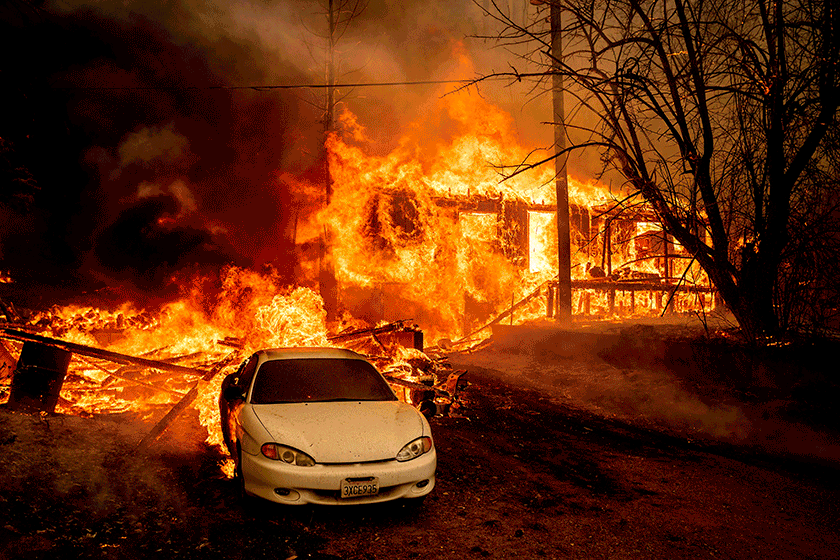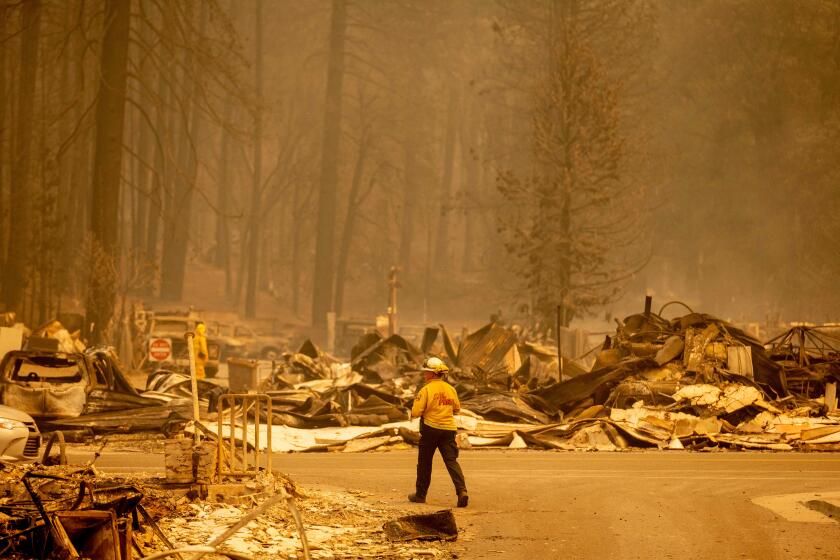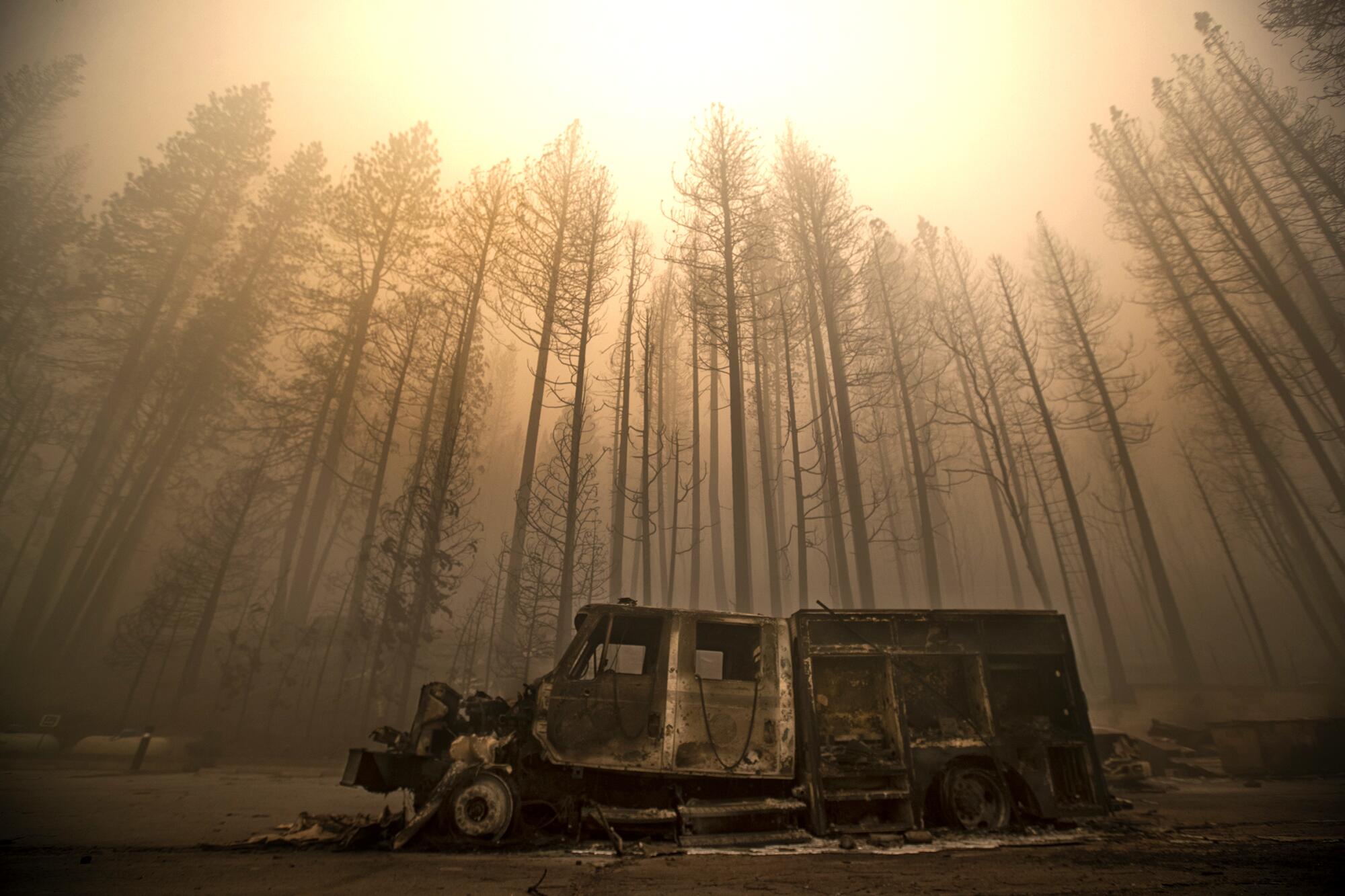
- Share via
Firefighters are hoping a break in the weather will help them get the upper hand on the massive Dixie fire in Northern California, which as of Saturday had destroyed at least 184 homes and commercial buildings and burned 446,723 acres.
Five people remained unaccounted for Saturday afternoon, although family members of two of them had contacted authorities to say they were OK, the Plumas County Sheriff’s Office said. All but one were from the town of Greenville, which was decimated earlier this week.
Containment of the fire, burning north of Sacramento, dropped from 35% to 21%, but that was a result of the fire’s growth, not firefighters losing ground, officials said. The fire is the third largest in California history and the biggest wildfire currently burning in the U.S.
“Even though we had what would be considered very little fire growth, we still added 13,000 acres to the size of the fire,” said Rick Carhart, public information officer with the California Department of Forestry and Fire Protection. “So that just speaks to how massive this fire is.”
Four firefighters were injured when a tree branch fell on them about 1:30 a.m. Saturday, according to officials. Three were treated and released, and one remained hospitalized in stable condition.
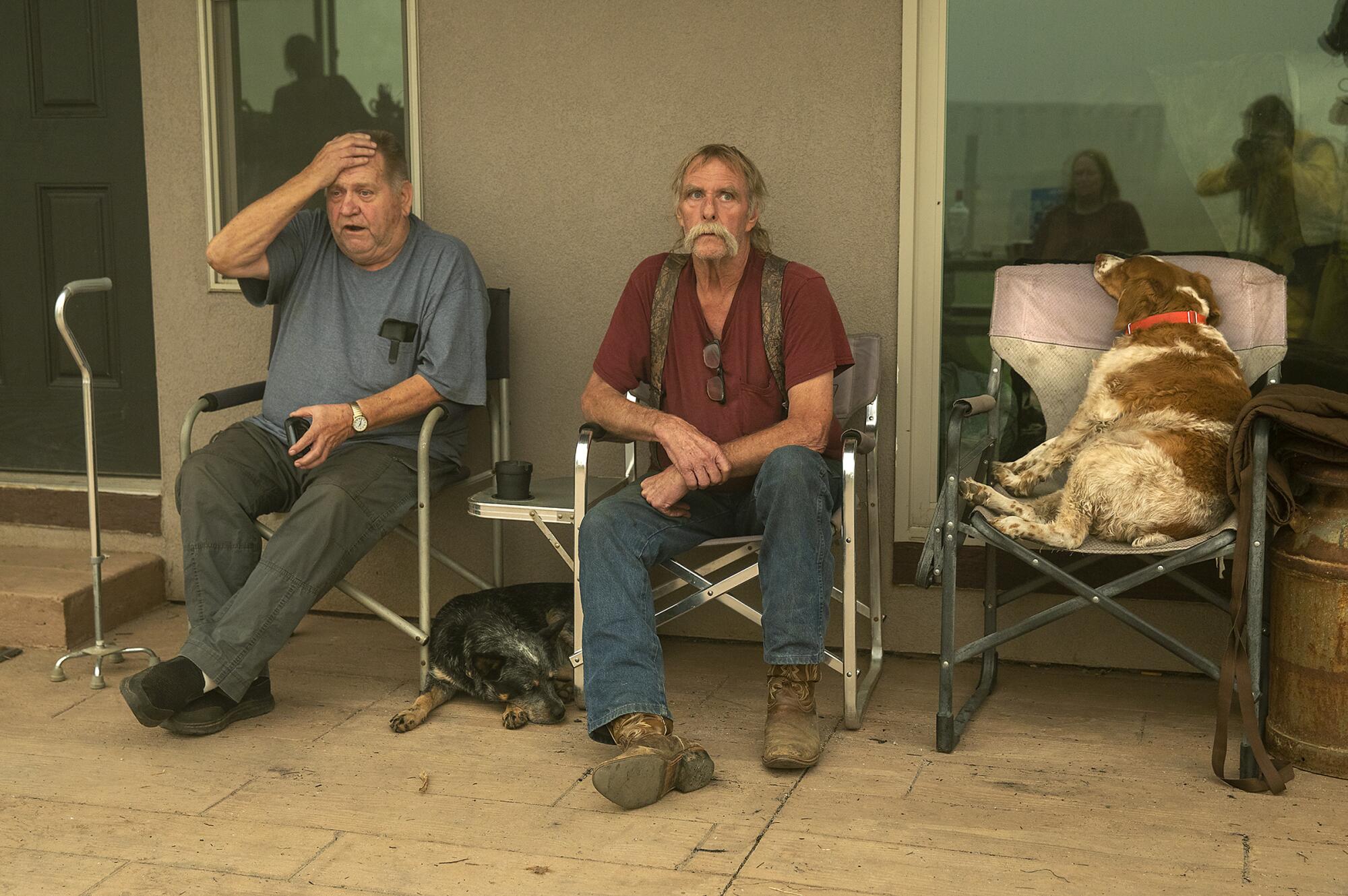
Fire activity slowed Friday and was expected to remain minimal Saturday, said Edwin Zuniga, another public information officer on the fire. The wildfire is burning in Plumas, Butte, Lassen and Tehama counties.
“Right now we basically have a blanket of smoke covering the fire area, which is shielding us from direct sunlight,” he said.
Although the smoke resulted in dismal air quality across the region, it was helping to suppress fire activity by keeping temperatures down, humidity values slightly higher and wind speeds slightly lower.
“The fire has kind of capped itself,” said Scott Rowe, meteorologist with the National Weather Service in Sacramento.
One challenge for fire crews in Plumas County is residents who won’t leave their property, forcing firefighters to take risks on their behalf.
Cooler temperatures also help keep the atmosphere more stable, meaning there’s less of an opportunity for the fire to send up a large plume of ash and smoke that can generate its own weather and create dangerous firefighting conditions, he said.
“That’s good news for our firefighters on the ground,” Zuniga said. “It gives them the opportunity to be more direct and aggressive when building containment lines.”
At the same time, the smoke was compromising visibility, limiting the use of firefighting aircraft, authorities said.
“It’s definitely a trade-off,” Carhart said. “When we have clearer air, the aircraft can fly and do their work, but we also have the possibility of these more extreme fire conditions.”
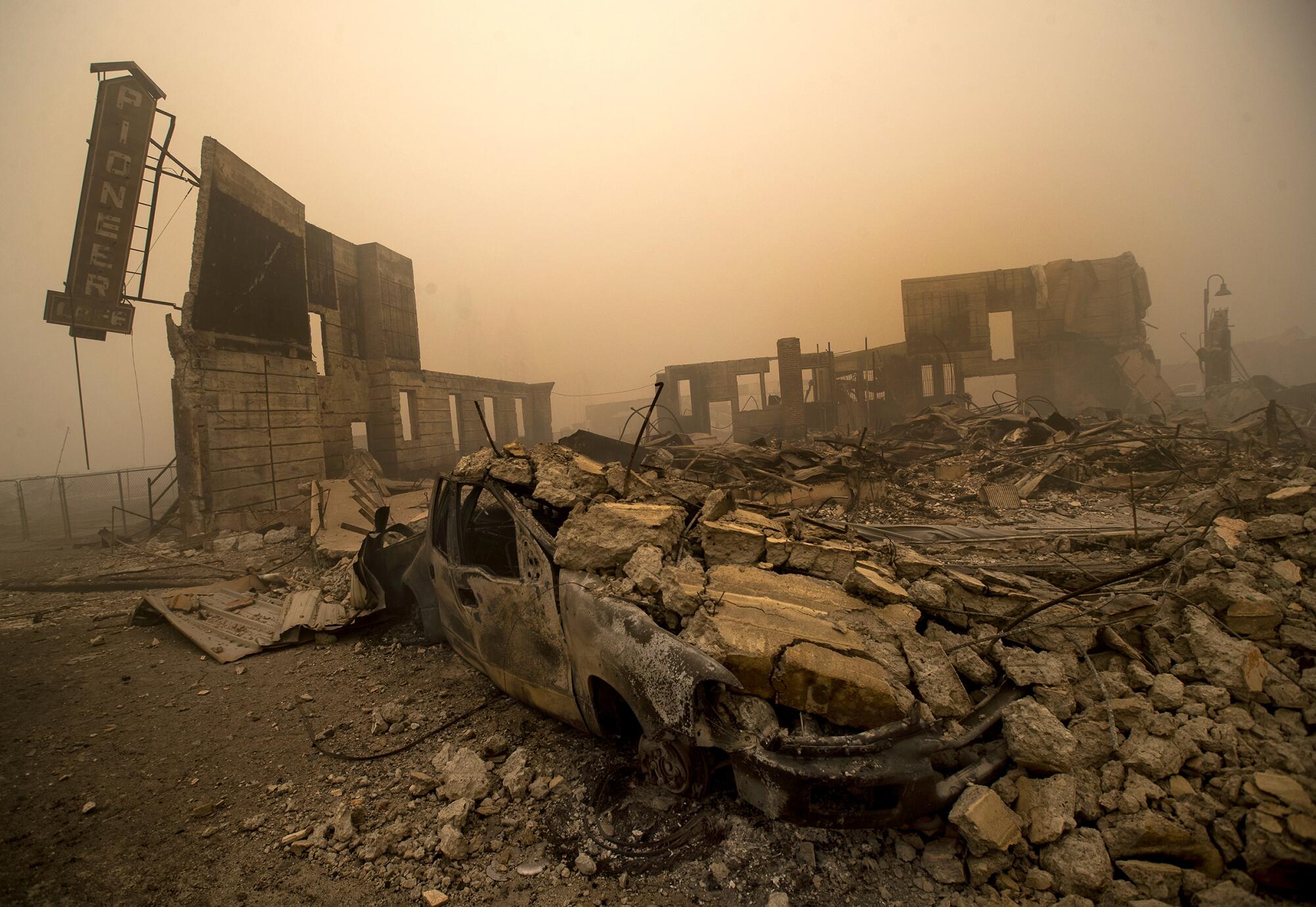
Winds were expected to pick up later Saturday afternoon and then again Sunday evening, with gusts of 15 to 25 mph, which could help clear out the smoke from portions of the Sacramento Valley but might also push the fire around, Rowe said. It’s also possible winds could be locally gustier in the area of the fire, he said.
The fire ignited July 13 near a Pacific Gas and Electric Co. power station in Feather River Canyon and might have been caused by a Douglas fir falling on a power line, PG&E said. The utility has said its equipment might also be to blame for sparking the Fly fire, which started nine days later and eventually merged with the Dixie fire, as well as a separate wildfire in Magalia that was extinguished at a quarter-acre July 14.
Despite the improved weather conditions, crews fighting the Dixie fire remained vigilant Saturday. Given the fire’s size and the historically dry conditions, exacerbated by temperatures sent rising by human-caused climate change, fire officials feared that embers could at any time cross containment lines and ignite spot fires that race toward populated areas. That scenario played out Wednesday night when the fire destroyed Greenville more than three weeks after it began.
“The vegetation is extremely dry, extremely receptive to fire,” Zuniga said. “Any little spark can establish a fire and make a run.”

Crown fires, in which flames travel across treetops — out of firefighters’ reach — have also been posing a challenge, spewing embers and at times forcing crews to withdraw and get out ahead of the fire, he said.
Communities around Lake Almanor remained threatened, especially on the western shore, where the fire was near. Fire crews were assigned to the north end of the Lake Almanor Peninsula, where they were patrolling for embers and building contingency lines in case the fire reached the area, Zuniga said.
They’ve been assisted by airplanes that fly above firefighting aircraft and use infrared cameras to detect spot fires.
“They can spot hot spots that are outside of our containment lines that firefighters on the ground would never be able to find if they weren’t directed to them,” Carhart said.
Greenville, a Gold Rush town dating to the 19th century, rebuilt after an 1881 fire. Now it has been destroyed by the Dixie fire, California’s largest this year.
There were about 5,118 personnel assigned to the fire, down from more than 5,200 days before, but authorities described that as a normal fluctuation made necessary by the fact that the fire has been raging for nearly a month.
“What’s basically happening is some of these resources are going home to do a personnel swap, do a reset or get fresh members on either engines or crews, and come back out to the fire,” Zuniga said.
The fire was burning through all kinds of different terrain — from steep, thickly timbered areas to flatter brush and grasslands — with its sheer size posing logistical hurdles. The fire on Friday surpassed the Bootleg fire in Oregon to become the largest in the United States this year.
“Just trying to make the plans and get everybody to the right places, it’s a huge job,” Carhart said. “I would say that’s the challenge right now, is taking this huge fire and breaking it up into pieces and getting it under control as best we can.”
Time was of the essence, as the favorable weather conditions weren’t expected to last long. A warming trend was forecast to start early in the week, with temperatures pushing above normal by the week’s end, Rowe said.
“It is going to get hot and it’s going to get sunny, and the wind is going to blow so we know that — that’s just life in Northern California,” Carhart said. “So while we have this favorable weather, we’re going to take advantage of it and do everything we can to get as far ahead of the game as we can before the weather turns on us again.”
Meanwhile, a federal judge on Friday ordered PG&E to further explain its role in the ignition of both the Dixie and Fly fires.
U.S. District Judge William Alsup, who is overseeing the utility’s criminal probation stemming from an explosion of one of its gas lines that killed eight people in 2010, also ordered the utility to provide a list by Aug. 16 of all fires its equipment has started so far this season.
In an earlier court filing, PG&E described a series of delays and mishaps that took place in the hours after it recorded a disturbance along a distribution line and a loss of power at Cresta Dam on July 13. As a result, an employee did not reach the site of the malfunctioning equipment and observe flames until about 10 hours later.
In the filing, PG&E provided the following account:
At 6:48 a.m., the same time the dam lost power, PG&E equipment recorded a disturbance along a distribution line. Current levels exceeded the threshold to trip the line, but they were not elevated for long enough for it to be deenergized.
A roving operator was sent to the Cresta Dam and confirmed the outage, but it’s not clear whether that employee checked the fuses.
The company’s control center then dispatched a troubleman. The field order was characterized as nonemergency, and it was initially assigned to a troubleman in the wrong service area before it was reassigned to someone closer more than an hour later.
The troubleman headed over to the dam, addressing another ticket he’d received along the way. Using binoculars, he spotted what appeared to be a fuse hanging down from a pole on the circuit in a remote area across the river. To get there, he had to drive down Highway 70, cross the river and drive up a long, unpaved access road on which he could at times drive no faster than 3 mph.
Two to three miles away from his destination, the troubleman ran into a Butte County road crew that was performing bridge maintenance, blocking the only way in. He returned about an hour and a half later, and though the bridge was still closed, the crew appeared to have finished their repairs, so he drove around the closure sign.
The troubleman finally arrived at the pole at 4:40 p.m. and saw that two conductors were tripped, a tree was leaning against the line, and a 600- to 800-square-foot fire was burning.
When he radioed dispatch operators for help, no one answered. Still, a PG&E worker heard the radio report and notified Cal Fire at 5:06 p.m., the utility said.
Unsure if help was on the way, the troubleman tried to fight the fire himself, taking a fire extinguisher from his truck and sliding 60 to 80 yards down to where the flames were. After he emptied the extinguisher, and a second one, he used a McLeod tool to try to dig a fire break near the access road. By then, he estimated the fire had grown to about 1,200 square feet.
Cal Fire aircraft arrived about 5:30 p.m., and a four-person ground crew was on scene around 7 p.m., according to PG&E. Its truck was unable to cross the closed bridge, so the troubleman drove there and ferried them across, the utility said.
Cal Fire would report later in the evening that the fire had grown to 10 to 15 acres.
More to Read
Sign up for Essential California
The most important California stories and recommendations in your inbox every morning.
You may occasionally receive promotional content from the Los Angeles Times.
